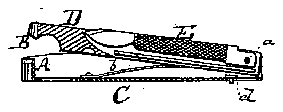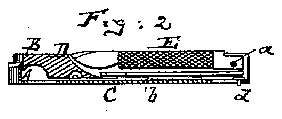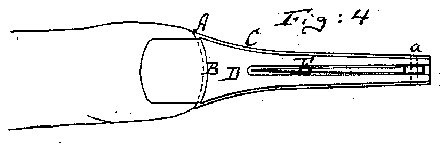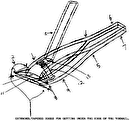



- 3william
Description
W. C. EDGE.
FINGER-NAIL TRIMMER.
No.183,Z56, Patented 0ct.17,1876.
N. PETERS. Pucno-LITHOGMPnEm WASHINGTON. 0 C4 $110.1: fizwizfif I UNITED STATES PATENT QFFICE.
WILLIAM 0. EDGE, OF NEWARK, NEW JERSEY.
IMPROVEMENT IN FlNGER-NAIL TRIMMERS.
Specification forming part of Letters Patent No. [83,256, dated October 17, 1876; application filed September 23, 1876.
To all whom it may concern: I
Be it known that I, WILLIAM (3. EDGE, of
Newark, Essex county, New Jersey, have invented an Improved Finger-Nail Trimmer, of which the following is a specification Figure l is a longitudinal vertical section of my improved finger-nail trimmer, showing it sprung open. Fig. 2 is a similar View thereof, showing it closed. Fig. 3 is a front view and Fig. 4 a top view, of the same.
Similar letters of reference indicate corresponding parts in all the figures.
This invention relates to an improved implement for trimming the nails of fingers and toes; and consists, principally, in the use of a concave cutter fastened to a pivoted bar, combined with another concave cutter which is attached to the frame of said pivoted bar, all as hereinafter more fully described.
In the accompanying drawing, the letter A represents the fixed cutter, and B the movable cutter, of my trimmer. Both these outters are concave in form, the one B being somewhat smaller, and capable of fitting into the convex side of the cutter A. The cuttingedge of the cutter B is made slanting, as in Fig. 3, to produce a shear-like cut. The stationary cutter A is rigidly attached to the end of a frame or shell, 0, which, in its opposite end, carries the pivot a of the blade or bar D, to which the upper cutter B is fastened. A
suitable spring, 12, is interposed between the parts 0 D to hold the two cutters separated,
and yet allow them to be brought together. A suitable latch, d, may be applied to the frame 0, for the purpose of locking the bar D in the contracted or closed position. A penknife or other knife, E, may be pivoted in the bar D, or in the frame or shell 0, or more such knives may be applied in suitable manner; but these do not form a part of my present invention. The concavity of the knives A B is such that the nails of smaller or larger fingers may be conveniently and properly trimmed, whenever the instrument is applied,
by alternately compressing and raising the WILLIAM 0. EDGE.
Witnesses:
ERNEST G. WEBB, A. V. BRIESEN.
